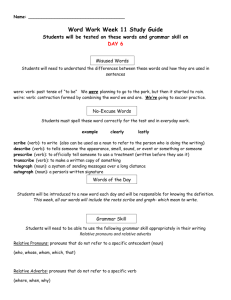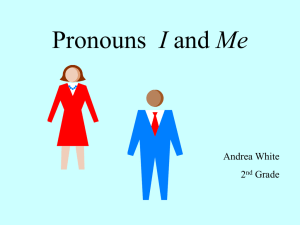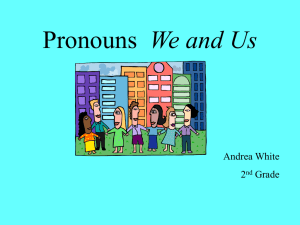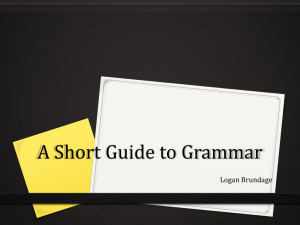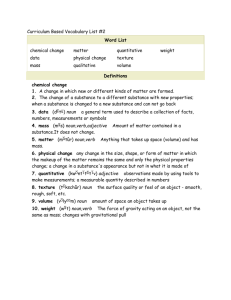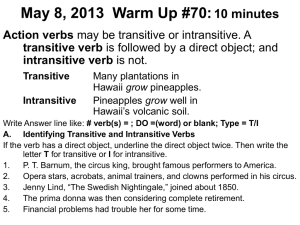ANT/ENG/LIN 516 - Study guide for the midterm exam
advertisement
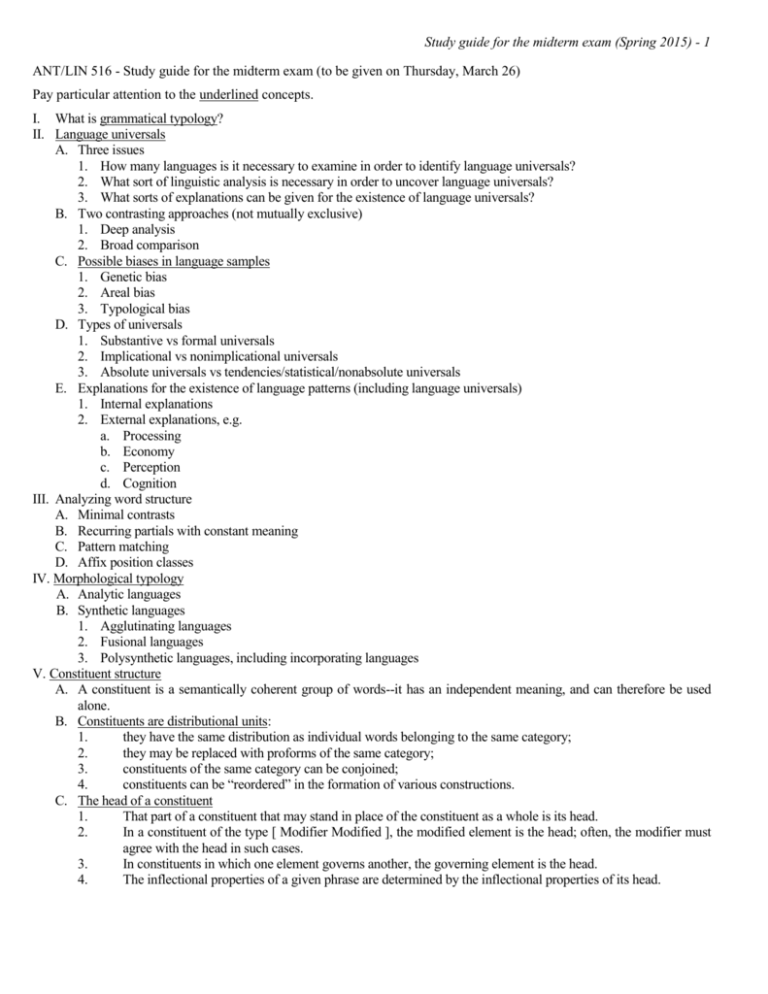
Study guide for the midterm exam (Spring 2015) - 1 ANT/LIN 516 - Study guide for the midterm exam (to be given on Thursday, March 26) Pay particular attention to the underlined concepts. I. What is grammatical typology? II. Language universals A. Three issues 1. How many languages is it necessary to examine in order to identify language universals? 2. What sort of linguistic analysis is necessary in order to uncover language universals? 3. What sorts of explanations can be given for the existence of language universals? B. Two contrasting approaches (not mutually exclusive) 1. Deep analysis 2. Broad comparison C. Possible biases in language samples 1. Genetic bias 2. Areal bias 3. Typological bias D. Types of universals 1. Substantive vs formal universals 2. Implicational vs nonimplicational universals 3. Absolute universals vs tendencies/statistical/nonabsolute universals E. Explanations for the existence of language patterns (including language universals) 1. Internal explanations 2. External explanations, e.g. a. Processing , The mouse the cat the dog bit chased b. Economy, si of predictaequent things: gapping, t ans to YNQs c. Perception d. Cognitionsu III. Analyzing word structure A. Minimal contrasts B. Recurring partials with constant meaning C. Pattern matching D. Affix position classes IV. Morphological typology A. Analytic languages B. Synthetic languages 1. Agglutinating languages 2. Fusional languages 3. Polysynthetic languages, including incorporating languages V. Constituent structure # terms \ negative contraction A. A constituent is a semantically coherent group of words--it has an independent meaning, and can therefore be used alone. B. Constituents are distributional units: 1. they have the same distribution as individual words belonging to the same category; 2. they may be replaced with proforms of the same category; 3. constituents of the same category can be conjoined; 4. constituents can be “reordered” in the formation of various constructions. C. The head of a constituent 1. That part of a constituent that may stand in place of the constituent as a whole is its head. 2. In a constituent of the type [ Modifier Modified ], the modified element is the head; often, the modifier must agree with the head in such cases. 3. In constituents in which one element governs another, the governing element is the head. 4. The inflectional properties of a given phrase are determined by the inflectional properties of its head. Study guide for the midterm exam (Spring 2015) - 2 D. Syntactic categories 1. Criteria for syntactic category membership a. Constituents belonging to the same syntactic category are alike in their syntactic distribution. b. Constituents belonging to the same syntactic category are similar in their internal structure. Lexical vs phrasal categories: the lexical category X heads the phrasal category XP. c. Constituents belonging to the same syntactic category are similar in their morphological behavior. 2. Major (vs minor) categories may function as heads of phrases; open (vs closed) categories have large, fluid membership. E. Labelled tree diagrams F. Structural vs lexical ambiguity G. Phrase structure rules VI. Semantic roles and grammatical relations A. Sentences and propositions B. Predicates and arguments C. Semantic roles D. Grammatical relations: Direct arguments (subject, object); oblique arguments E. Indirect objects; primary vs secondary objects F. Arguments vs adjuncts G. Some processes that are sensitive to semantic roles and grammatical relations VII. Lexical entries and well-formed clauses A. Lexical entries B. Argument structure, subcategorization and linking rules C. Transitivity, valence and valence alternations D. Well-formedness conditions on clauses E. Selectional restrictions F. Pro-drop languages VIII. Noun phrases A. The complement/adjunct distinction in NPs 1. Noun complements: PP, S′ 2. Noun adjuncts: PP, S′, AP 3. In English, a noun’s complements precede its adjuncts. B. Determiners 1. Determiners include articles, demonstratives, and possessive pronouns 2. In English, a determiner comes before the noun it modifies as well as before any adjectives that modify it. C. Possessors 1. A possessor NP occupies the same position as a determiner. 2. In English, the suffix -’s that marks a possessor NP is an edge inflection. D. A category intermediate between NP and N: N′ 1. Using N′ to account for the position of determiners and possessor NPs 2. Using N′ to account for the relative position of complements and adjuncts within NPs 3. Confirming evidence in English: The proform one substitutes for N′. E. Recursion within NPs IX. Case and agreement A. Government vs agreement B. Case 1. Grammatical vs semantic case 2. Synthetic vs analytic expressions of case C. Agreement 1. Agreement relations in syntax a. A phrase-internal modifier agrees with the head of the phrase. b. A predicate agrees with one or more of its arguments. c. An anaphor agrees with its antecedent. Study guide for the midterm exam (Spring 2015) - 3 2. Categories of agreement a. Person b. Number c. Gender d. Case D. Systems of case-marking and verb agreement: 1. In an ACCUSATIVE language such as English, the subject of an intransitive verb and the subject of a transitive verb function identically with respect to rules of case and/or agreement, and they function differently from the object of a transitive verb with respect to such rules. 2. In an ERGATIVE language such as Dyirbal, the subject of an intransitive verb and the object of a transitive verb function identically with respect to rules of case and/or agreement, and they function differently from the subject of a transitive verb with respect to such rules. 3. In an ACTIVE language such as Choctaw, the subject of an active intransitive verb and the subject of a transitive verb function identically with respect to rules of case and/or agreement, while the subject of a stative intransitive verb and the object of a transitive verb function identically with respect to such rules. 4. Mixed systems X. Noun classes and pronouns A. Gender 1. What is gender? 2. How many genders? 3. Assigning nouns to genders a. Semantic assignment b. Morphological assignment c. Phonological assignment B. Noun classifiers 1. What are noun classifiers? 2. How noun-classifier systems differ from gender systems C. Pronouns 1. Personal pronouns a. What is a personal pronoun? b. Anaphoric vs deictic uses of personal pronouns c. Categories encoded by personal pronouns 2. Some other sorts of pronouns a. Reflexive pronouns b. Reciprocal pronouns c. Demonstrative pronouns d. Relative pronouns e. Interrogative pronouns
